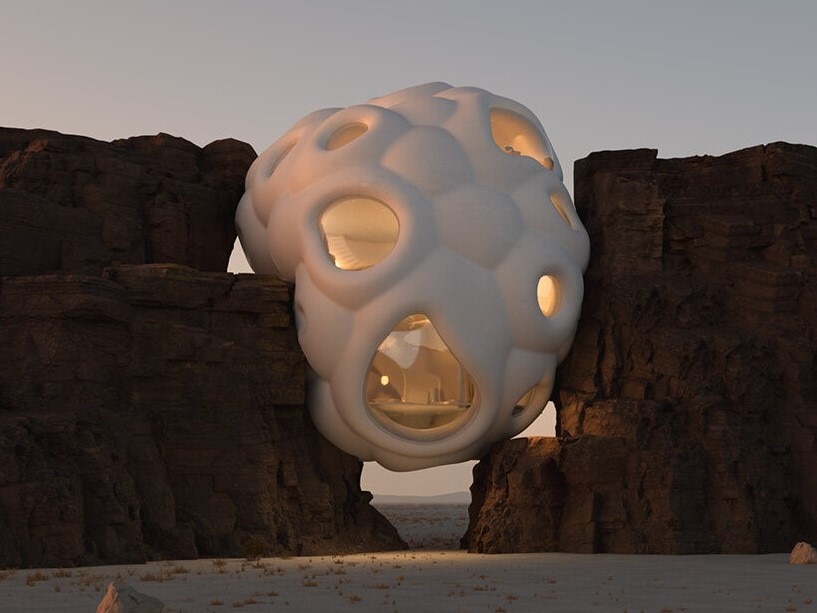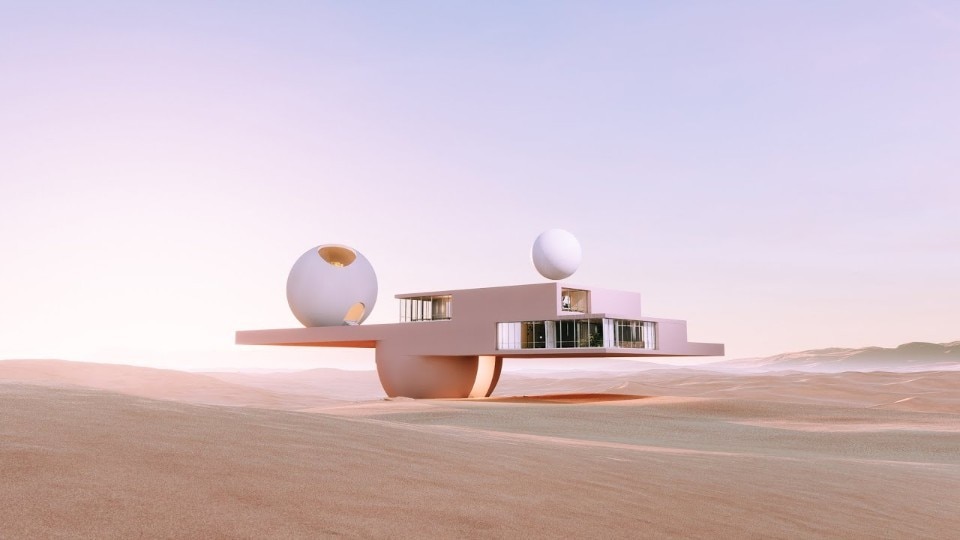The study “The State of AI in Architecture” commissioned by Chaos, a 3D visualisation software company, has recently analysed AI's broader implications on the design process by surveying 1,227 global designers and revealing that AI use in architecture is significant and destined to be integrated permanently.
Respondents were asked about their current use of AI for design, the challenges they face with today's AI tools, the type of regulation needed for the future, and their views on how AI will impact their profession. The findings revealed that AI is predominantly used in the early stages of conceptual design, improving efficiency (60%), creativity (57%) and unlocking creative workflows, albeit 62% would desire greater precision and reliability in AI tools. The research also highlighted how self-learning is widespread in the sector, reflecting a lack of defined as well as ethical guidelines for AI use in architectural design.

 View gallery
View gallery

Liberland Metaverse, Zaha Hadid Architects
The digital world designed by Patrik Schumacher and his team is a “high-fidelity and photorealistic” metaverse destined to “spatially host the citizens and collaborators of Liberland, in anticipation of its physical realization.” ZHA designed “the initial seed cluster of buildings including a congressional hall, a digital art plaza (NFT plaza) and galleries, decentralized finance office spaces (DeFi plaza), start-up incubator building.”
Courtesy Zaha Hadid Architects

Architecting the metaverse, Zaha Hadid Architects and Refik Anadol Studio
This year, while the images generated by TTI software invaded our social media feed, among the criticism about copyrights and the debates of bias and censorship, ZHA in collaboration with Refik Anadol Studio has been using its pre-public access to DALL-E 2 through its project “Architecting the metaverse” in order to experiment the prompt engineering and partially automate the process of interpretation of 2D images generated in 3D spatial scenes.
Courtesy Zaha Hadid Architects

Architecting the metaverse, Zaha Hadid Architects and Refik Anadol Studio
Courtesy Zaha Hadid Architects

The Row, Every Realm
The Row is a project by Every Realm, a place where artists like Daniel Arsham, Alexis Christodoulou, Misha Kahn, Andrés Reisinger, Six N. Five, Hard have been invited to imagine architectural and artistic structures in a world where physics poses no limitations: “no gravity, no climate, no construction materials.” The only law The Row has seems to be that of sales.
Courtesy Every Realm

The Shipping, Andrés Reisinger
The Argentinian designer Andrés Reisinger had already experimented something similar when, in 2021 in a NFT online auction entitled “The Shipping,” he sold ten virtual pieces of furniture made in a surrealistic and impossible style. The pieces were sold as .obj and could be placed in any shared 3D virtual space or metaverse.
Courtesy Andrés Reisinger

Viceverse BIG, Bjarke Ingels Group
BIG, Bjarke Ingels Group, designed new virtual headquarters on Decentraland for the Vice Media Group that was named “viceverse.” The initiative is one of the many experimental projects by Virtue Futures, the innovation branch of Virtue, Vice’s creative agency. The white and sinuous building was designed to work as a virtual lab for innovation and experimentation on topics like NFT, DAO, and web 3.0 for the agency teams distributed over 25 countries around the world.
Courtesy Bjarke Ingels Group

Wired Next Fest, Monogrid
The explosion in the demand for digital spaces gave the chance to “lay” figures to explore the world of architectural design. That’s what happened to the Italian interactive design studio Monogrid during the creation of the DMAT Virtual Showroom and of the digital venue for the WIRED NEXT FEST 2022. During this project, the studio took the “chance to express a vision of virtual spaces unthreaded from the limitations and restrictions that physics imposes on offline architecture.”
Courtesy Monogrid

Liberland Metaverse, Zaha Hadid Architects
The digital world designed by Patrik Schumacher and his team is a “high-fidelity and photorealistic” metaverse destined to “spatially host the citizens and collaborators of Liberland, in anticipation of its physical realization.” ZHA designed “the initial seed cluster of buildings including a congressional hall, a digital art plaza (NFT plaza) and galleries, decentralized finance office spaces (DeFi plaza), start-up incubator building.”
Courtesy Zaha Hadid Architects

Architecting the metaverse, Zaha Hadid Architects and Refik Anadol Studio
This year, while the images generated by TTI software invaded our social media feed, among the criticism about copyrights and the debates of bias and censorship, ZHA in collaboration with Refik Anadol Studio has been using its pre-public access to DALL-E 2 through its project “Architecting the metaverse” in order to experiment the prompt engineering and partially automate the process of interpretation of 2D images generated in 3D spatial scenes.
Courtesy Zaha Hadid Architects

Architecting the metaverse, Zaha Hadid Architects and Refik Anadol Studio
Courtesy Zaha Hadid Architects

The Row, Every Realm
The Row is a project by Every Realm, a place where artists like Daniel Arsham, Alexis Christodoulou, Misha Kahn, Andrés Reisinger, Six N. Five, Hard have been invited to imagine architectural and artistic structures in a world where physics poses no limitations: “no gravity, no climate, no construction materials.” The only law The Row has seems to be that of sales.
Courtesy Every Realm

The Shipping, Andrés Reisinger
The Argentinian designer Andrés Reisinger had already experimented something similar when, in 2021 in a NFT online auction entitled “The Shipping,” he sold ten virtual pieces of furniture made in a surrealistic and impossible style. The pieces were sold as .obj and could be placed in any shared 3D virtual space or metaverse.
Courtesy Andrés Reisinger

Viceverse BIG, Bjarke Ingels Group
BIG, Bjarke Ingels Group, designed new virtual headquarters on Decentraland for the Vice Media Group that was named “viceverse.” The initiative is one of the many experimental projects by Virtue Futures, the innovation branch of Virtue, Vice’s creative agency. The white and sinuous building was designed to work as a virtual lab for innovation and experimentation on topics like NFT, DAO, and web 3.0 for the agency teams distributed over 25 countries around the world.
Courtesy Bjarke Ingels Group

Wired Next Fest, Monogrid
The explosion in the demand for digital spaces gave the chance to “lay” figures to explore the world of architectural design. That’s what happened to the Italian interactive design studio Monogrid during the creation of the DMAT Virtual Showroom and of the digital venue for the WIRED NEXT FEST 2022. During this project, the studio took the “chance to express a vision of virtual spaces unthreaded from the limitations and restrictions that physics imposes on offline architecture.”
Courtesy Monogrid
The ethical dilemma inherent in the adoption of AI, from equity and transparency to accountability in architectural decision-making, has also been addressed by the Royal Institute of British Academy (RIBA)’s Artificial Intelligence Report 2024, another report interested in examining the transformative potential of AI and fostering “responsible stewardship” in the face of rapid technological changes. However, according to the Head of Architecture at Lancaster University and member of RIBA’s expert advisory group Des Fagan, even if AI is expected to deliver tangible benefits for architects in the near term, the profession is currently in a research and development phase.






